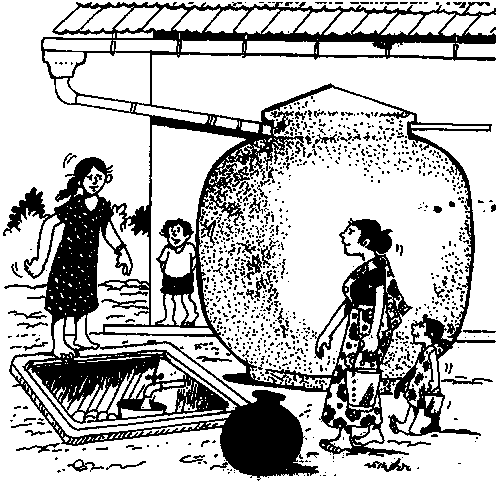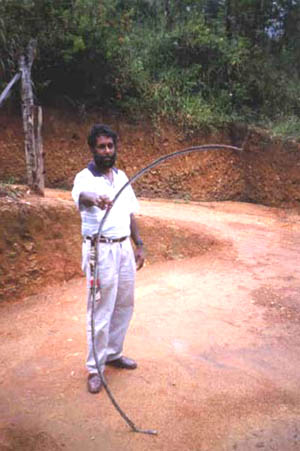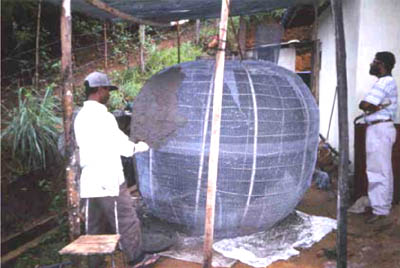How to Build a Rainwater Tank: Sri Lankan Pumpkin Tank
Contents
Short Description
- Problem:
- Idea:
- Difficulty:
- Price Range:
- Material Needeed:
- Geographic Area:
- Competencies:
- How Many people?
- How Long does it take?
The Sri Lankan Pumpkin Tank - A Case Study - Technical Brief
Background Information
The Sri Lankan Pumpkin Tank, and the associated construction technique, was developed as part of a World Bank sponsored Water and Sanitation Programme which was implemented in the country between 1995 and 1998. The Community Water Supply and Sanitation Programme (CWSSP) covered 3 districts within the country - Badulla, Ratnapura and Matara Districts. Hundreds of these tanks were built in areas where conventional supply schemes, such as piped supplies or groundwater supplies, were difficult to provide. In some areas members of the target community were given the choice of a RWH system for individual households or a groundwater supply for a group of households. The choice varied. In all cases there was a choice of type of tank - either the Pumpkin tank or an underground tank. The choice was usually a function of ground conditions rather than personal preference. Both tanks have a capacity of approximately 5m3.
The Abikon family of Demetaralhina in Badulla District chose a pumpkin tank. Their village is in a rural highlands area of the country and the ground conditions were not suitable for a groundwater supply or for digging a pit for a below ground tank. Average annual rainfall is 2250mm with a bimodal rainfall pattern (two wet seasons) and the longest dry period usually between December and April. Their per capita consumption was well below the 20 litres per day that each family member now consumes. The water is used for drinking (but only after boiling), cooking, personal and clothes washing. Mr Abikon also uses the water from their tank to water their 4 cows. Only towards the end of the dry season does the tank sometimes dry up and then the family has to walk to the spring, about ½ a mile from their home.
Figure 2:
File:P2a.jpg
One of the 10 legs used to form the skeleton frame.
Technical details
Rainwater is collected from only 1 side of the pitched roof, a collection area of 32m2. The roofing material is a mix of zinc and asbestos sheeting. The guttering is a PVC U-channel, factory manufactured, found commonly in the nearby town, fitted to a facia board with similarly manufactured brackets, spaced at 300mm centres. The downpipe is a standard 3” PVC pipe, although some of the neighbours use less costly downpipes made from string and plastic tubing. The cost of the guttering is approximately SLR5,600, about Sterling £86.00.
This pumpkin tank was built 3 years ago and is in very good condition. The construction is of ferrocement. The construction detail is given later. The cost of the tank is approximately SLR5,000 or Sterling £77.00. The materials and specialist labour for the tank were provided by CWSSP and the guttering was purchased by the Abikon family.
Water extraction is through a tap piped to a point slightly away from the tank, where the ground falls away and allows a bucket to be placed easily under the tap. There is a first flush mechanism fitted in the form of a simple PVC elbow with a length of pipe which diverts the dirty first water away from the inlet chamber. The inlet chamber also acts as the pre-filter chamber. The chamber is approximately 600mm cubed and contains subsequent layers of stone, charcoal and sand, through which rainwater passes.
Construction details
The following construction details are given in the instructions that are handed out to masons during their training session:
1. Prepare skeleton / framework legs (Figure 14) as shown in the drawing. 10 no. required. Prepare the crown ring. This can be used again for many tanks.
2. Lay the concrete base using two layers of chicken wire as reinforcing. Allow 300mm of chicken wire to protrude all around the edge of the base. This will be connected to the wall mesh later. Lay 10 anchor bolts for the legs in the base while casting (the diameter will depend on the diameter of the holes in the legs).
3. Leave the base for 7 days to cure, wetting each day.
4. Secure the 10 skeleton legs using the bolts and the crown ring.
5. Take 6mm steel rod and wrap it around the outside of the legs, starting at the bottom and working up at 10cm intervals.
6. Fix 2 layers of chicken wire over the outside of the skeleton. The filter tower can be added at this point if a filter is to be fitted.
7. Plaster the outside of the mesh. Leave for 1 day.
8. Go inside the tank and remove the skeleton.
9. Plaster inside the tank and cure for 7 days.
Water proofing can be added to the mortar. This can be a specialist additive or liquid dishwashing soap.
Cure the tank by wetting for 7 - 10 days. Fill the gradually starting on day 7, filling at a rate of approximately 300mm per day.
Materials and labour breakdown
|
Material |
Unit |
Qty |
Unit Cost |
Total cost |
|
Cement |
50kg bag |
8 |
265 |
2120 |
|
Sand |
ft3 |
55 |
3.5 |
192.5 |
|
Metal |
ft3 |
6 |
18 |
108 |
|
½” Chicken |
ft2 |
366 |
4 |
1464 |
|
Mesh | ||||
|
Mould |
1 |
325* |
325 | |
|
Transport |
500 | |||
|
Skilled labour |
hr |
56 |
22 |
1232 |
|
Unskilled labour |
hr |
112 |
12.5 |
1400 |
|
7341.5 |
* Assuming mould is used for 10 tanks
All costs given in Sri Lankan Rupees
(65 SL Rupees = Sterling £1.00 at the time of writing)
References and further reading
'This Howtopedia entry was derived from the Practical Action Technical Brief The Sri Lankan Pumpkin Tank - A Case Study.
To look at the original document follow this link:
http://www.practicalaction.org/?id=technical_briefs_water
Useful addresses
Practical Action
The Schumacher Centre for Technology & Development, Bourton on Dunsmore, RUGBY, CV23 9QZ, United Kingdom.
Tel.: +44 (0) 1926 634400, Fax: +44 (0) 1926 634401
e-mail:practicalaction@practicalaction.org.uk web:www.practicalaction.org



